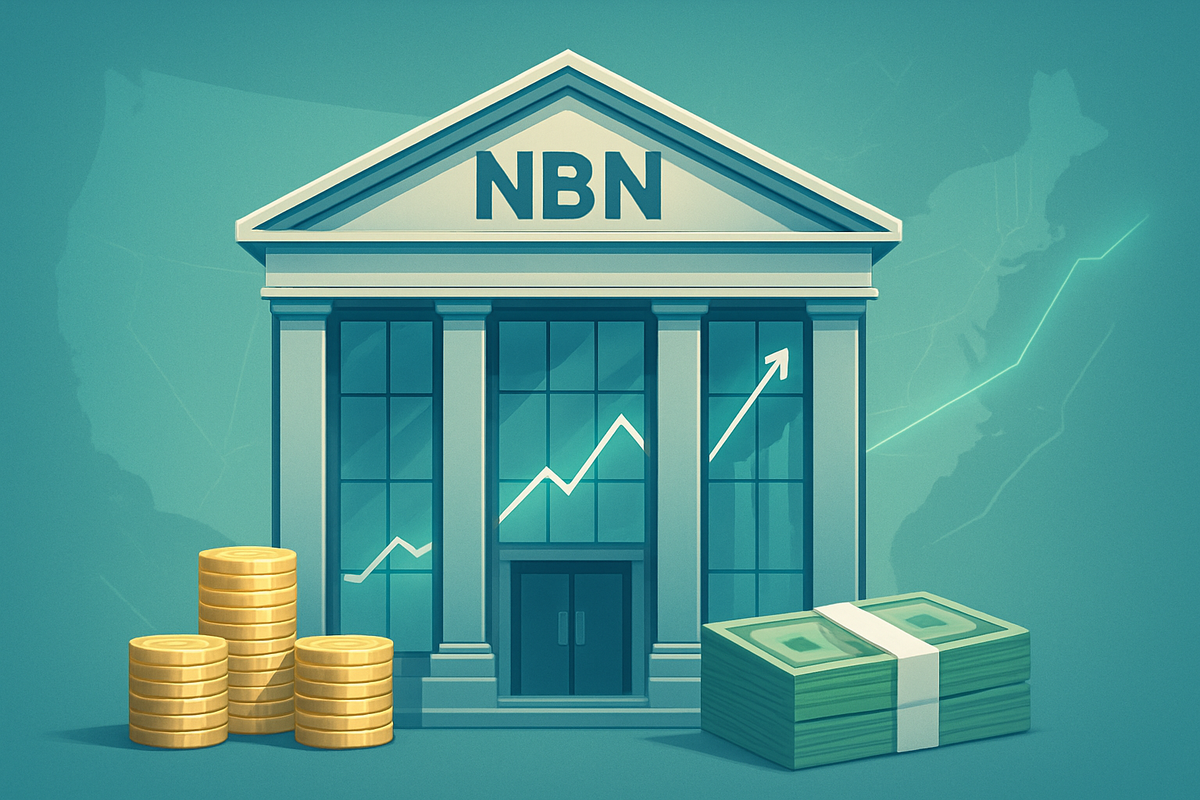
Northeast Bank (NASDAQ: NBN) has commenced its fiscal year 2026 with a strong performance, announcing a cash dividend of $0.01 per share alongside impressive first-quarter financial results for the period ending September 30, 2025. The regional bank reported a net income of $22.5 million, a substantial increase from the $17.1 million recorded in the same quarter of the previous fiscal year, demonstrating a significant year-over-year growth of 31.6%. This solid financial footing and commitment to shareholder returns signal a confident outlook for the institution amidst a dynamic financial landscape.
The dividend, scheduled for payment on November 25, 2025, to shareholders of record as of November 11, 2025, underscores Northeast Bank's consistent track record of returning value to its investors. The accompanying robust earnings, which saw diluted earnings per share (EPS) climb to $2.67 from $2.11 a year earlier, are likely to bolster investor confidence and draw positive attention to the bank's operational efficiency and strategic positioning in the regional banking sector.
Detailed Coverage: A Strong Start to Fiscal 2026
Northeast Bank's Board of Directors officially declared a cash dividend of $0.01 per share, with the payment set for November 25, 2025, to shareholders on record by November 11, 2025. This declaration follows the release of the bank's first fiscal quarter 2026 results, which concluded on September 30, 2025. The reported net income of $22.5 million was a highlight, driven by a notable increase in net interest and dividend income, which reached $48.2 million – an increase of $9.2 million from the prior year's first fiscal quarter. This surge was primarily fueled by higher interest income from loans, particularly from expanded average balances in the bank's National Lending Division and Small Business Administration (SBA) portfolios.
The bank also showcased strong profitability ratios, achieving an average return on equity (ROE) of 17.6% and an average return on assets (ROA) of 2.1%. Loan originations and purchases for the quarter totaled an impressive $278.4 million. Furthermore, Northeast Bank (NASDAQ: NBN) reinforced its financial stability with improved capital ratios, reporting a Tier 1 leverage ratio of 12.2% and a Total risk-based capital ratio of 15.1%. These figures reflect prudent financial management and a healthy balance sheet.
The timeline leading to these announcements began with Northeast Bank's notification on October 20, 2025, that it would release its fiscal 2026 first-quarter earnings results on Tuesday, October 28, 2025. The actual release and dividend declaration occurred as scheduled on October 28, 2025. Key stakeholders include the bank's management team, such as CEO Rick Wayne and CFO Richard Cohen, along with shareholders, investors, financial analysts, and its diverse customer base served through its Maine branches, National Lending Division, and online platform, ableBanking. Initial market reactions have been generally positive, with financial news outlets highlighting the strong performance, though some analysts, like Wall Street Zen, had previously issued "Hold" ratings, suggesting a nuanced view on long-term growth prospects despite the strong quarterly showing.
Market Ripple Effects: Winners and Losers in the Regional Banking Sector
Northeast Bank's (NASDAQ: NBN) robust fiscal Q1 2026 performance and consistent dividend declaration are poised to create discernible ripple effects across the regional banking sector. Its success, particularly in specialized areas like SBA loans and its National Lending Division, which acquires and originates commercial loans nationwide, sets a high bar and offers a blueprint for others.
Potential Winners from this event are likely to be well-managed regional banks with strong asset quality, diversified lending portfolios (especially those with less concentration in vulnerable commercial real estate without adequate security), and efficient operations. Banks that mirror NBN's focus on specialized lending or those with strong compliance frameworks, differentiating themselves in a post-regulatory settlement environment (such as the recent TD Bank settlement), could see increased investor confidence. Furthermore, regional banks that have invested in robust digital capabilities and streamlined operations may also attract investors seeking similar strong performance indicators and operational leverage.
Conversely, Potential Losers could include regional banks struggling with weaker fundamentals, such as lower profitability, declining net interest margins, or a higher proportion of non-performing loans, particularly those with less secured or concentrated commercial real estate exposure. Competitors unable to match NBN's efficiency in loan production or its diversification strategy might see their growth prospects diminish. Banks with less stable deposit bases or higher funding costs could also struggle to compete effectively. Smaller, purely local banks without a strong niche or diversified lending strategy might find it increasingly challenging to attract capital and talent when a regional peer like Northeast Bank performs exceptionally well. For partners, NBN's strong financial health could lead to increased business for service providers and stronger relationships for co-lending, but it might also give NBN more leverage in negotiations with its vendors.
The broader market perception of regional banks, while still cautious due to lingering credit fears, receives a positive signal from NBN's results. It reinforces the idea that well-managed regional banks can thrive, but also highlights disparities, leading investors to scrutinize competitors more closely.
Wider Significance: Navigating 2025's Evolving Banking Landscape
Northeast Bank's (NASDAQ: NBN) strong first fiscal quarter 2026 performance and dividend declaration are particularly significant as they unfold within a complex and evolving landscape for the regional banking sector in late 2025. The industry is experiencing both significant tailwinds and persistent challenges. Positive trends include a steepening yield curve, which benefits net interest margins, anticipated increases in loan activity, an acceleration of mergers and acquisitions (M&A) driven by regulatory easing, and an overall more favorable regulatory environment under a new presidential administration. Regional bank stocks also continue to present attractive valuations.
However, formidable challenges persist. Regional banks face disproportionate exposure to vulnerable Commercial Real Estate (CRE) markets, particularly office properties, where delinquency rates are nearing 2008 peaks. Concerns about rising bad loans, margin compression due to high deposit costs, cybersecurity threats, and the struggle with digital transformation against agile fintechs also loom large. Northeast Bank's ability to generate robust net income and grow capital amidst these pressures suggests effective risk management and a sound business model, setting it apart. Its strong capital ratios (Tier 1 leverage capital ratio of 12.2% and Total risk-based capital ratio of 15.1%) place it well above regulatory minimums, enhancing its resilience.
The consistent dividend, part of a 37-year track record, signals financial stability and confidence, aligning with a broader trend of banks returning excess capital as regulatory environments potentially ease. Historically, banks with such "dividend champion" status are often characterized by quality business models and a reluctance to engage in riskier lending practices, a profile NBN seems to fit. Its success could inspire other regional banks to strengthen their niche offerings and risk management. The event also has regulatory implications: NBN's strong capital position indicates it is well-placed to meet stress test requirements, allowing for sustained dividend payouts. Broader regulatory discussions, such as a push for a "single, risk-based" capital standard, could further benefit well-capitalized institutions like Northeast Bank.
What Comes Next: Strategic Adaptations and Market Opportunities
Following its impressive first fiscal quarter of 2026, Northeast Bank (NASDAQ: NBN) is poised for continued profitability in the short term, driven by its growing National Lending and SBA portfolios. However, the bank has acknowledged a potential near-term dip of up to 50% in SBA lending volume due to recent eligibility tightening and increased documentation requirements. This necessitates strategic adaptations, such as optimizing internal processes for new SBA requirements or reinforcing its focus on its National Lending Division's non-SBA commercial real estate (CRE) loan acquisitions to compensate for any shortfalls. Continued investment in digital transformation and AI integration, exemplified by its partnership with Narmi for digital account opening, will be crucial for enhancing customer experience and operational efficiency. Diversifying revenue streams beyond net interest income could also provide long-term stability. Given the accelerating M&A trend in regional banking, Northeast Bank could either become an attractive acquisition target or strategically pursue its own acquisitions to expand its footprint or service offerings.
For the broader regional banking sector, late 2025 and beyond present several opportunities: a steepening yield curve could alleviate net interest margin pressure, loan demand is expected to rebound across all categories, and attractive valuations continue to draw investor interest. M&A activity is expected to accelerate, offering growth avenues. However, significant challenges persist, notably the substantial CRE exposure, particularly in office properties, which could lead to elevated credit losses. Credit quality normalization, interest rate volatility, cybersecurity threats, and intense competition from larger banks and fintechs remain critical hurdles. Geopolitical and macroeconomic uncertainties further complicate the outlook.
Potential scenarios for Northeast Bank and its investors range from continued strong performance, where the bank leverages its unique lending strategies to maintain profitability and consistent dividends, to moderate headwinds requiring adaptive strategies, or even a worst-case scenario involving a severe CRE downturn and significant credit losses. Investors should anticipate Northeast Bank's disciplined approach to asset quality and strategic pivots to be critical in navigating these possibilities, ensuring long-term value in a complex financial environment.
Comprehensive Wrap-up: A Beacon of Stability
Northeast Bank's (NASDAQ: NBN) robust first fiscal quarter 2026 earnings and consistent dividend declaration mark a significant moment for the institution and offer valuable insights into the resilience of well-managed regional banks. With a net income of $22.5 million and strong capital ratios, the bank has demonstrated its capacity for growth and stability in an environment still grappling with the complexities of interest rate dynamics and commercial real estate risks. The long-standing dividend payment history further solidifies its image as a reliable investment.
Moving forward into late 2025, the regional banking market presents a dichotomy of promising opportunities, such as a steepening yield curve and a rebound in loan activity, alongside persistent challenges like CRE exposure and margin pressures. Northeast Bank's diversified business model, including its National Lending Division and online ableBanking, positions it to potentially leverage these opportunities while mitigating risks. Its ability to generate consistent earnings and improve capital ratios in a turbulent period serves as a positive indicator for its operational strategy and capacity to navigate market volatility.
Investors should closely monitor Northeast Bank's subsequent earnings reports for sustained profitability and asset quality, paying particular attention to any shifts in its loan portfolio, especially regarding CRE. Management commentary on strategic direction and adaptation to evolving market conditions, such as the anticipated changes in SBA lending, will be crucial. For the broader financial sector, watching Federal Reserve policy on interest rates, CRE trends, M&A activity, and the evolving regulatory environment will provide essential context for regional bank performance. Northeast Bank's performance stands as a testament to strategic management and could serve as a beacon for other regional institutions striving for stability and growth in an ever-changing financial landscape.
This content is intended for informational purposes only and is not financial advice






